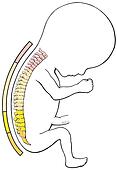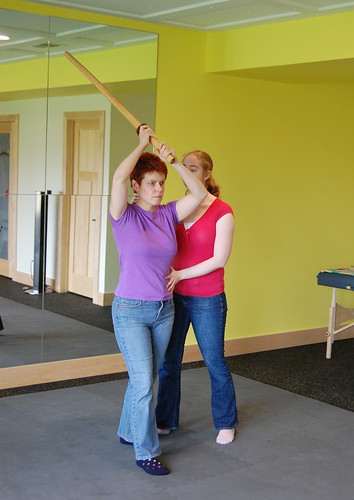Concept Spotlight: Primary and Secondary Curves
A few months ago I talked about Developmental Movement and the work of Raymond Dart. There are many ways that Alexander teachers can incorporate Dart’s work into lessons, but the one that appeals the most to me is the idea of what I call “the building blocks of movement.” Today I’ll be discussing two of these building blocks: Primary and Secondary Curves.
First, it’s important to remember that the spine is not a straight line; there are natural curves in the spine, both forward and backward. These curves allow it to function as a sort of spring or shock-absorber, and give it the flexibility to be able to adapt and respond to movement. These curves appear at the very beginning of the developmental process, and as such we refer to them as Primary and Secondary curves.
 While in the womb, the spine of the fetus needs to be curved in order to fit into such a tight space. If you look at an illustration of a fetus in the womb you’ll see that the spine is curved forward, bringing the front side of the body closer in on itself. Since this pattern is the first one that develops, we refer to it as Primary Curve. Any movements we perform as adults that tend towards this forward curve are reflections of that building block of Primary Curve.
While in the womb, the spine of the fetus needs to be curved in order to fit into such a tight space. If you look at an illustration of a fetus in the womb you’ll see that the spine is curved forward, bringing the front side of the body closer in on itself. Since this pattern is the first one that develops, we refer to it as Primary Curve. Any movements we perform as adults that tend towards this forward curve are reflections of that building block of Primary Curve.
When a baby is a newborn, they cannot support their own head. This is because the muscles in the back of the neck haven’t begun to engage – what we sometimes refer to as “plugging in.” Once those muscles begin to engage, the baby can start to look up and around, and support their own head.  This looking up from the floor gives the beginning of what we call Secondary Curve – the spinal extension that tends towards an arched back. We refer to it as Secondary because it is the second basic movement pattern that we learn as babies. As adults, any movements that tend to arch our back are reflections of Secondary Curve.
This looking up from the floor gives the beginning of what we call Secondary Curve – the spinal extension that tends towards an arched back. We refer to it as Secondary because it is the second basic movement pattern that we learn as babies. As adults, any movements that tend to arch our back are reflections of Secondary Curve.
As an Alexander teacher, I use these building blocks to help students break down complex movements into combinations of these simple ones. It becomes particularly useful with students who have physical careers, such as dancers, martial artists, atheletes, etc. If a student is having trouble with a particular movement, we’ll often look at it from a perspective of Primary and Secondary curves, identifying whether the movement should tend towards Primary or Secondary, and whether the student’s performance of the movement is actually working with these building blocks.
 A ballet dancer who keeps falling out of her back attitude might find that her spine is tending toward Secondary, when what she really needs is to tend towards Primary in order to counterbalance the elevated back leg. A modern dancer might find that his high release improves when he thinks of the full connection and direction of a Secondary curve rather than simply crunching back onto his lumbar spine. A martial artist might find that the weight of her sword overhead is causing her to fall backwards, and she needs to tend more towards Primary to counteract that.
A ballet dancer who keeps falling out of her back attitude might find that her spine is tending toward Secondary, when what she really needs is to tend towards Primary in order to counterbalance the elevated back leg. A modern dancer might find that his high release improves when he thinks of the full connection and direction of a Secondary curve rather than simply crunching back onto his lumbar spine. A martial artist might find that the weight of her sword overhead is causing her to fall backwards, and she needs to tend more towards Primary to counteract that.
Next time, we’ll discuss another of the building blocks of movement: spirals.
Forward and Up! is a Pittsburgh-based private practice offering quality instruction in the Alexander Technique in a positive and supportive environment.


